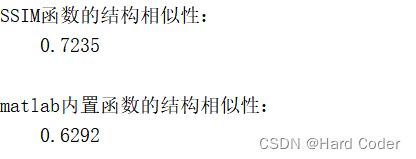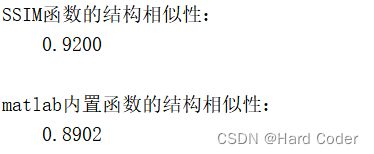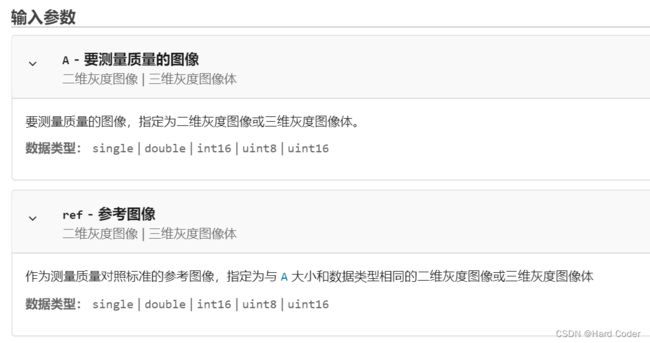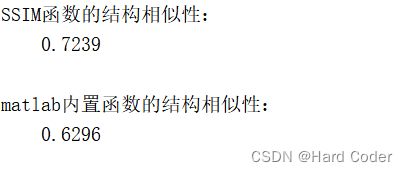图像处理之图像质量评价指标SSIM(结构相似性)
一、SSIM基本定义
SSIM全称为“Structural Similarity Index”,中文意思即为结构相似性,是衡量图像质量的指标之一。给定两张图像x和y,其结构相似性可以定义为:
matlab中对SSIM的文档说明:
SSIM的范围为[0,1],其值越大,表示图像的质量越好。当两张图像一模一样时,此时SSIM=1。计算SSIM有两种方法:
方法一:使用开源结构相似性函数
方法二:直接使用matlab的内置函数ssim()
二、matlab实现SSIM
1、方法二:SSIM.m
function [mssim, ssim_map] = SSIM(img1, img2, K, window, L)
% ========================================================================
% SSIM Index with automatic downsampling, Version 1.0
% Copyright(c) 2009 Zhou Wang
% All Rights Reserved.
%
% ----------------------------------------------------------------------
% Permission to use, copy, or modify this software and its documentation
% for educational and research purposes only and without fee is hereby
% granted, provided that this copyright notice and the original authors'
% names appear on all copies and supporting documentation. This program
% shall not be used, rewritten, or adapted as the basis of a commercial
% software or hardware product without first obtaining permission of the
% authors. The authors make no representations about the suitability of
% this software for any purpose. It is provided "as is" without express
% or implied warranty.
%----------------------------------------------------------------------
%
% This is an implementation of the algorithm for calculating the
% Structural SIMilarity (SSIM) index between two images
%
% Please refer to the following paper and the website with suggested usage
%
% Z. Wang, A. C. Bovik, H. R. Sheikh, and E. P. Simoncelli, "Image
% quality assessment: From error visibility to structural similarity,"
% IEEE Transactios on Image Processing, vol. 13, no. 4, pp. 600-612,
% Apr. 2004.
%
% http://www.ece.uwaterloo.ca/~z70wang/research/ssim/
%
% Note: This program is different from ssim_index.m, where no automatic
% downsampling is performed. (downsampling was done in the above paper
% and was described as suggested usage in the above website.)
%
% Kindly report any suggestions or corrections to zhouwang@ieee.org
%
%----------------------------------------------------------------------
%
%Input : (1) img1: the first image being compared
% (2) img2: the second image being compared
% (3) K: constants in the SSIM index formula (see the above
% reference). defualt value: K = [0.01 0.03]
% (4) window: local window for statistics (see the above
% reference). default widnow is Gaussian given by
% window = fspecial('gaussian', 11, 1.5);
% (5) L: dynamic range of the images. default: L = 255
%
%Output: (1) mssim: the mean SSIM index value between 2 images.
% If one of the images being compared is regarded as
% perfect quality, then mssim can be considered as the
% quality measure of the other image.
% If img1 = img2, then mssim = 1.
% (2) ssim_map: the SSIM index map of the test image. The map
% has a smaller size than the input images. The actual size
% depends on the window size and the downsampling factor.
%
%Basic Usage:
% Given 2 test images img1 and img2, whose dynamic range is 0-255
%
% [mssim, ssim_map] = ssim(img1, img2);
%
%Advanced Usage:
% User defined parameters. For example
%
% K = [0.05 0.05];
% window = ones(8);
% L = 100;
% [mssim, ssim_map] = ssim(img1, img2, K, window, L);
%
%Visualize the results:
%
% mssim %Gives the mssim value
% imshow(max(0, ssim_map).^4) %Shows the SSIM index map
%========================================================================
if (nargin < 2 || nargin > 5)
mssim = -Inf;
ssim_map = -Inf;
return;
end
if (size(img1) ~= size(img2))
mssim = -Inf;
ssim_map = -Inf;
return;
end
[M N] = size(img1);
if (nargin == 2)
if ((M < 11) || (N < 11))
mssim = -Inf;
ssim_map = -Inf;
return
end
window = fspecial('gaussian', 11, 1.5); %
K(1) = 0.01; % default settings
K(2) = 0.03; %
L = 255; %
end
if (nargin == 3)
if ((M < 11) || (N < 11))
mssim = -Inf;
ssim_map = -Inf;
return
end
window = fspecial('gaussian', 11, 1.5);
L = 255;
if (length(K) == 2)
if (K(1) < 0 || K(2) < 0)
mssim = -Inf;
ssim_map = -Inf;
return;
end
else
mssim = -Inf;
ssim_map = -Inf;
return;
end
end
if (nargin == 4)
[H W] = size(window);
if ((H*W) < 4 || (H > M) || (W > N))
mssim = -Inf;
ssim_map = -Inf;
return
end
L = 255;
if (length(K) == 2)
if (K(1) < 0 || K(2) < 0)
mssim = -Inf;
ssim_map = -Inf;
return;
end
else
mssim = -Inf;
ssim_map = -Inf;
return;
end
end
if (nargin == 5)
[H W] = size(window);
if ((H*W) < 4 || (H > M) || (W > N))
mssim = -Inf;
ssim_map = -Inf;
return
end
if (length(K) == 2)
if (K(1) < 0 || K(2) < 0)
mssim = -Inf;
ssim_map = -Inf;
return;
end
else
mssim = -Inf;
ssim_map = -Inf;
return;
end
end
img1 = double(img1);
img2 = double(img2);
% automatic downsampling
f = max(1,round(min(M,N)/256));
%downsampling by f
%use a simple low-pass filter
if(f>1)
lpf = ones(f,f);
lpf = lpf/sum(lpf(:));
img1 = imfilter(img1,lpf,'symmetric','same');
img2 = imfilter(img2,lpf,'symmetric','same');
img1 = img1(1:f:end,1:f:end);
img2 = img2(1:f:end,1:f:end);
end
C1 = (K(1)*L)^2;
C2 = (K(2)*L)^2;
window = window/sum(sum(window));
mu1 = filter2(window, img1, 'valid');
mu2 = filter2(window, img2, 'valid');
mu1_sq = mu1.*mu1;
mu2_sq = mu2.*mu2;
mu1_mu2 = mu1.*mu2;
sigma1_sq = filter2(window, img1.*img1, 'valid') - mu1_sq;
sigma2_sq = filter2(window, img2.*img2, 'valid') - mu2_sq;
sigma12 = filter2(window, img1.*img2, 'valid') - mu1_mu2;
if (C1 > 0 && C2 > 0)
ssim_map = ((2*mu1_mu2 + C1).*(2*sigma12 + C2))./((mu1_sq + mu2_sq + C1).*(sigma1_sq + sigma2_sq + C2));
else
numerator1 = 2*mu1_mu2 + C1;
numerator2 = 2*sigma12 + C2;
denominator1 = mu1_sq + mu2_sq + C1;
denominator2 = sigma1_sq + sigma2_sq + C2;
ssim_map = ones(size(mu1));
index = (denominator1.*denominator2 > 0);
ssim_map(index) = (numerator1(index).*numerator2(index))./(denominator1(index).*denominator2(index));
index = (denominator1 ~= 0) & (denominator2 == 0);
ssim_map(index) = numerator1(index)./denominator1(index);
end
mssim = mean2(ssim_map);
return
2、主函数main.m
clc;clear;close all;
rgbimage=imread('boy.jpg');
attack_rgbimage=imnoise(rgbimage,'salt & pepper',0.1);
figure(1),
subplot(121),imshow(rgbimage);
title('原始图像');
subplot(122),imshow(attack_rgbimage);
title('噪声攻击图像');
ssimval1=SSIM(rgbimage,attack_rgbimage);% 方法一
disp('SSIM函数的结构相似性:');
disp(ssimval1);
ssimval2=ssim(rgbimage,attack_rgbimage);% 方法二
disp('matlab内置函数的结构相似性:');
disp(ssimval2);
三、实现结果分析
1、注意每次运行主函数main.m文件,输出的SSIM值都会有细微差别,可以对比上下两张图。

2、可以发现开源函数计算的SSIM值总比matlab内置函数计算的SSIM值大,具体原因不可知。
3、仅以椒盐噪声的参数为讨论,我们将主函数main.m文件椒盐噪声的方差改为0.01,可以与上方得到方差为0.05的SSIM结果进行对比,可以看出得到的SSIM要大很多。

参考博客:图像质量评估指标:MSE,PSNR,SSIM




